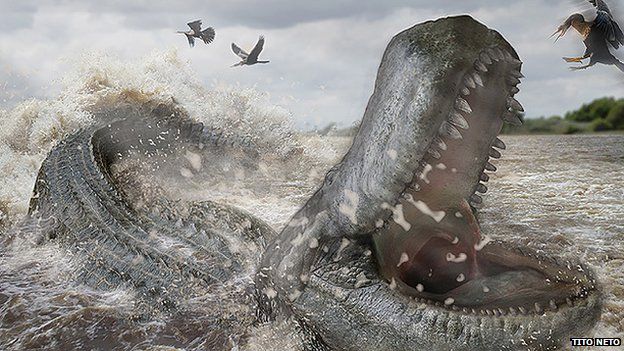Prehistoric caiman's bite 'twice as strong' as T-Rex's
- Published

A prehistoric caiman that lived in the Amazon region about eight million years ago had a bite twice as powerful as that of a Tyrannosaurus Rex, Brazilian scientists say.
A team of Brazilian paleontologists calculated the strength of a bite by the Purussaurus brasiliensis, a reptile that lived in the Late Miocene period.
They said it could exert a pressure up to 11.5 tonnes.
That is 20 times the strength of a white shark's bite.
Tito Aureliano, one of the co-authors of the study, said the animal's head was better structured for biting than that of the T-Rex.
The Purussaurus's stout and robust skull with conical teeth were made for gripping large prey.
The findings by the team drawn from a number of research and academic institutions were published in the online Plos One journal.
Purussaurus brasiliensis could reach a length of more than 12.5m (41ft), longer than a London bus, and was an unrivalled predator in its wetland habitat, the researchers said.
"The Purussaurus and the Tyrannosaurus lived in different ages but there is no doubt that the Purussaurus would have won a fight between the two of them," Aline Ghilardi, one of the co-authors of the study, told BBC Brasil.
The paleontologist from Rio de Janeiro's Federal University said that while the Purussaurus was discovered in the 19th Century, it had been not been the focus of much scientific study despite its dominance in the Amazon region during its heyday.
Ms Ghilardi said that while it may have had no natural predators, the Purussaurus fell victim to the geological movements that led to the rise of the Andes mountain range.
"The rise of the Andes changed everything for the Purossaurus, which previously thrived on the presence of huge mammals in the regions," she said.
The reptile needed more than 40kg of meat a day, 20 times the amount modern-day alligators eat, she explained.
"The swamplands were radically changed and the led to the demise of several species," she added.
- Published26 February 2015
- Published26 February 2015
- Published15 April 2014